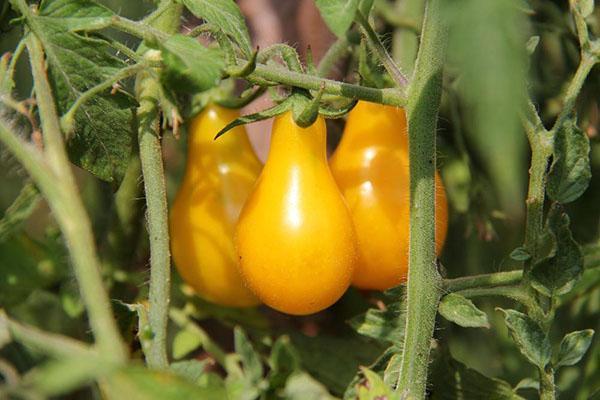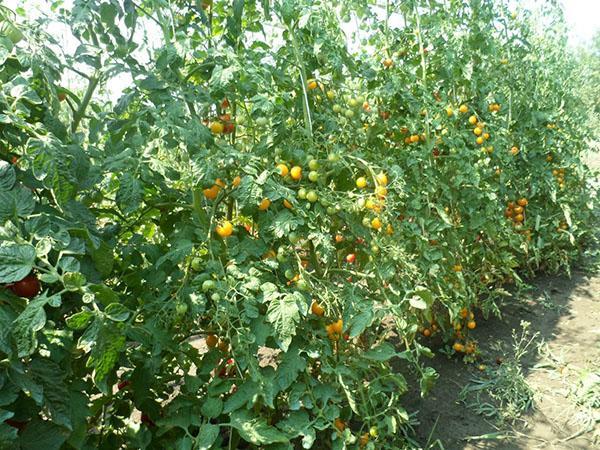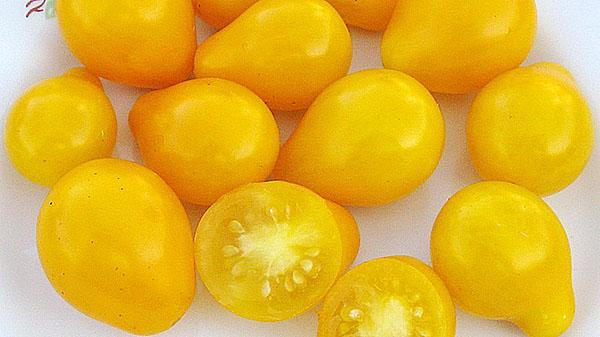Growing a tomato Honey drop: planting and proper care
 Growing a tomato honey drop is very popular among gardeners. If you plant the plant correctly and follow the simple rules of care, you can get a high-quality and bountiful harvest. This variety of tomatoes is not demanding. Therefore, in order to achieve what you want, you need to observe watering and apply the required amount of fertilizers.
Growing a tomato honey drop is very popular among gardeners. If you plant the plant correctly and follow the simple rules of care, you can get a high-quality and bountiful harvest. This variety of tomatoes is not demanding. Therefore, in order to achieve what you want, you need to observe watering and apply the required amount of fertilizers.
Honey drop: characteristics and description of the variety

Due to the high percentage of sugar, honey drop is often used to make jam from cherry tomatoes.
Among the main advantages of the variety:
- it can be propagated by seeds collected from ripe tomatoes;
- the number of germinated seeds reaches 95%;
- tomatoes have a pleasant taste and aroma;
- they are suitable for fresh consumption and for preparations for the winter;
- the plant is highly productive.
Sweetish tomatoes are delicious fresh. With their bright color they will decorate any salad and will become an irreplaceable part of the garnish. Such tomatoes are added to juices and soups. Amber fruits in jars look no less beautiful. Especially if you can simultaneously preserve small red and yellow tomatoes.
The honey drop has its drawbacks. Due to their tallness, the bushes require pinching. Tomatoes should be tied to a stable support, watered in a timely manner, do not forget to feed, and also planted in a suitable soil for them.
Tomatoes Honey drop: planting, selection of seeds and selection of soil
 To get a good harvest, seedling seeds are sown in the first week of March. Grown plants are transplanted into a greenhouse or open beds in late spring or early June.
To get a good harvest, seedling seeds are sown in the first week of March. Grown plants are transplanted into a greenhouse or open beds in late spring or early June.
Soil selection and lighting
 The honey drop is quite demanding on the substrate. The land for her needs to be taken only nutritious. The best option is light soil made from a mixture of earth and sand, supplemented with compost. Once every 7-9 days, the beds should be weeded to remove weeds and loosen the soil. In order to speed up the germination of grains, it is recommended to add fertilizers based on potassium and phosphorus compounds to the soil.
The honey drop is quite demanding on the substrate. The land for her needs to be taken only nutritious. The best option is light soil made from a mixture of earth and sand, supplemented with compost. Once every 7-9 days, the beds should be weeded to remove weeds and loosen the soil. In order to speed up the germination of grains, it is recommended to add fertilizers based on potassium and phosphorus compounds to the soil.
In cloudy weather, seedlings must be additionally illuminated with lamps, otherwise this will negatively affect young tomatoes.
 Due to the fact that the Honey Drop is very picky about the soil, in the greenhouse to grow it, you will have to replace the top layer of the earth every year.
Due to the fact that the Honey Drop is very picky about the soil, in the greenhouse to grow it, you will have to replace the top layer of the earth every year.
The choice of planting material
 In order to grow a young plant, you can use both purchased and self-collected seeds from ripe fruits. To prepare planting material, it is enough to cut the tomatoes, grind the pulp through a sieve and rinse thoroughly under running water. The resulting seeds are dried on paper or napkin. Then they are collected in paper bags and stored in a dark place, making sure that insects or rodents do not get to them.
In order to grow a young plant, you can use both purchased and self-collected seeds from ripe fruits. To prepare planting material, it is enough to cut the tomatoes, grind the pulp through a sieve and rinse thoroughly under running water. The resulting seeds are dried on paper or napkin. Then they are collected in paper bags and stored in a dark place, making sure that insects or rodents do not get to them.
The seeds give the greatest germination in the first 3 years after collection, but they can be stored for up to 7 years.
Planting seeds
 Before proceeding with sowing seeds, they must be treated with a solution of hydrogen peroxide or potassium permanganate. After that, the grains are placed in a moist soil mixture, deepening by about 2 cm. The containers are covered with polyethylene until the first shoots appear. Seedlings should be grown at a temperature of +22 - +250 C. After a week or 10 days, young sprouts should appear from the ground.
Before proceeding with sowing seeds, they must be treated with a solution of hydrogen peroxide or potassium permanganate. After that, the grains are placed in a moist soil mixture, deepening by about 2 cm. The containers are covered with polyethylene until the first shoots appear. Seedlings should be grown at a temperature of +22 - +250 C. After a week or 10 days, young sprouts should appear from the ground.
Growing a tomato Honey drop: plant care
 After the first leaves appear, the plants must be dived. Containers with seedlings are well watered, then each specimen is planted in a separate container (pot, container, glass). When diving tomatoes, it is recommended to shorten (pinch) the main root a little. This will allow the root system to develop properly and form many new roots. When planting, the stem of the plant is deepened into the soil along the lower leaves.
After the first leaves appear, the plants must be dived. Containers with seedlings are well watered, then each specimen is planted in a separate container (pot, container, glass). When diving tomatoes, it is recommended to shorten (pinch) the main root a little. This will allow the root system to develop properly and form many new roots. When planting, the stem of the plant is deepened into the soil along the lower leaves.
Planting seedlings in open ground
 Before planting seedlings in their permanent place, young plants should be prepared for new conditions - hardening. To do this, boxes with tomatoes are taken out for several hours in fresh air. They are planted in the greenhouse at the end of May. If it is planned to grow the Honey Drop immediately in the garden, then planting is carried out at the very end of May or even at the beginning of June.
Before planting seedlings in their permanent place, young plants should be prepared for new conditions - hardening. To do this, boxes with tomatoes are taken out for several hours in fresh air. They are planted in the greenhouse at the end of May. If it is planned to grow the Honey Drop immediately in the garden, then planting is carried out at the very end of May or even at the beginning of June.
Seedling planting scheme
 Planting tomatoes.Honey drop is necessary according to the scheme 40 x 70 cm. But the distance between the rows of tomatoes can be reduced to 40-45 cm. This will not affect the yield, the number of fruits will not decrease, but this approach will significantly save the area on the site.
Planting tomatoes.Honey drop is necessary according to the scheme 40 x 70 cm. But the distance between the rows of tomatoes can be reduced to 40-45 cm. This will not affect the yield, the number of fruits will not decrease, but this approach will significantly save the area on the site.
Watering and fertilizing
 Tomatoes of this variety need a regular, systematic watering... It is best to carry out the procedure every 6-7 days. The water for irrigation must settle and warm up.
Tomatoes of this variety need a regular, systematic watering... It is best to carry out the procedure every 6-7 days. The water for irrigation must settle and warm up.
As a fertilizer, you need to use compounds that include organics and various minerals. Before adding the granules are diluted in water at room temperature. Watering the seedlings both in greenhouses and in the beds should be 1 every two weeks.
In order for the bushes not to break, it is necessary to install special supports. Both greenhouse and garden specimens are tied up. Vertical or horizontal trellises are installed in the greenhouse. In the beds, tomato bushes have a lower height, so they are tied to a net or wooden pegs.
Also, do not forget about plant formation... To get a good harvest, 2-3 stems are left on the bushes, and the rest are cut off.
The Honey Drop variety has many advantages and only minor disadvantages. Therefore, this type of tomato is very popular among summer residents.